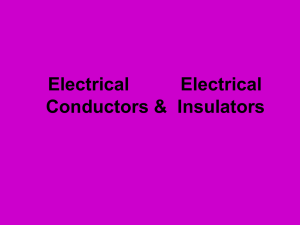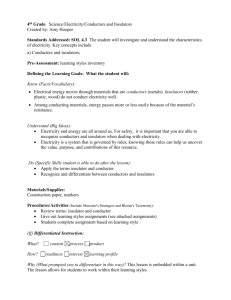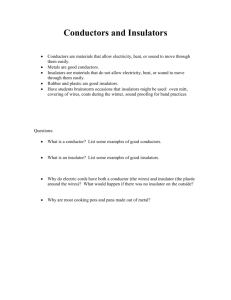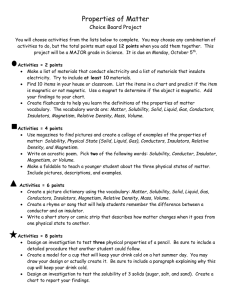Insulators and Conductors
advertisement
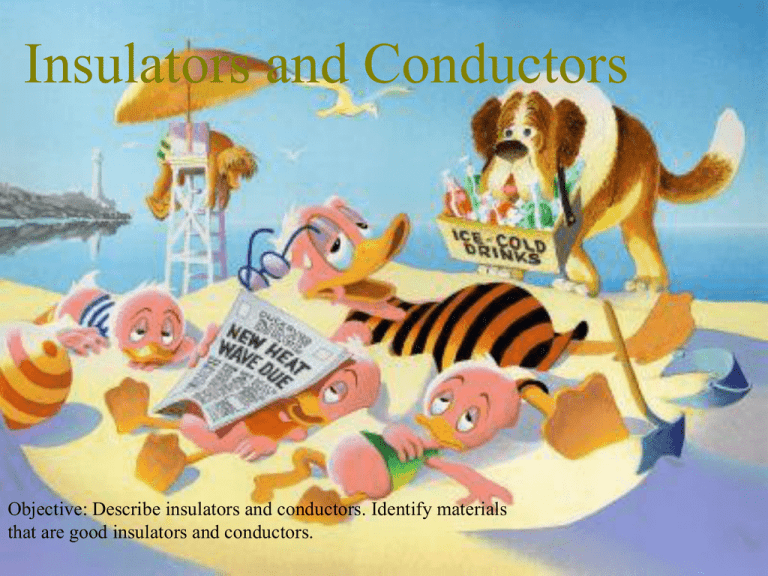
Insulators and Conductors Objective: Describe insulators and conductors. Identify materials that are good insulators and conductors. Heat Transfer • Heat always moves from a warmer place to a cooler place. • Hot objects in a cooler room will cool to room temperature after the hot object transfers some of their heat to the cold object. • Cold objects in a warmer room will heat up to room temperature. Why does metal feel colder than wood, if they are both at the same temperature? Metal is a conductor, wood is an insulator. Metal conducts the heat away from your hands. Wood does not conduct the heat away from your hands as well as the metal, so the wood feels warmer than the metal. At home energy is TRANSFERRED in lots of ways. Look at this saucepan where potatoes are being boiled. Heat energy is being transferred from the electric ring to the glass hob. Heat energy is being transferred from the glass hob to the metal saucepan. Heat energy is being transferred from the metal saucepan to the water and potatoes. Then can I transfer the potatoes from the pan to my stomach? What do we call things that allow heat energy to transfer easily? They are called conductors. Solid fuel stove Good conductors feel cold when there is no source of heat. They don’t retain heat but let it be transferred away. Metal hob The heat energy is transferred from the burning fuel, to the metal hob, to the metal saucepan and kettle and then to the water. Heat energy is being transferred from the water to the spoon in the Sometimes we don’t want heat to be transferred, we want to keep the heat in. What do you know about all these things? Hats, coats, gloves and scarves are all insulators. They make it difficult for heat energy to be transferred from your body to the cold air, so they keep you warm. What is a conductor? • A conductor is something which allows electricity to flow through. • An example of a conductor is: – – – – – – Scissors Paper clip Aluminum foil Iron Steel Copper Look at these containers. They will be filled with hot water. Which ones do you think are conductors that will allow the transfer of heat energy most easily? How will I know which containers conduct heat energy most easily? glass Paper cup Clue Polystyrene cup Metal mug Pottery mug Plastic mug Examples of Conductors • Metal • Glass •Paper Electrical Conductor Example: Objects that allow electrical charge to flow easily Example: The coil from a electric heater gets hot and conducts electricity well Conductor: a material that transmits electrical energy easily Metals make the best conductors Property of Electrical Conductor: In all good conductors electric current flows through them without resistance Example: Electricity flows through the coil in the power line coils easily and without resistance Good Conductors • Metal is a good conductor of electricity What is a Insulator? • An insulator is what help keeps electricity from not flowing • Examples of insulators are: – Cotton – Plastic – Rubber Insulators • We use INsulators when we want to keep the heat IN – so the amount of heat/temperature stays about the same OR we use an insulator when we DO NOT want the heat to pass through easily, so we won’t be burnt. – Example: Thermos, Oven Mitts, Styrofoam cup with hot coffee, Winter Jacket, Rubber, blanket. Look at these things. These are insulators too. What do they do? Tea cosy, burger box and thermos flask all prevent the transfer of heat. Thermos • A thermos is a container that is capable of keeping hot items hot and cold items cold. • A thermos, a cooler or even an insulated cup works by preventing transfers of heat! What are Insulators? • Insulators are materials that do not allow heat to move easily through them. Conductors & Insulators Insulator: a material that resists or blocks the flow of electrons through it Good Insulators: Why Metals Feel Cool to the Touch at Room Temperature • Room temperature is cooler than human body temperature. • Heat is ONLY noticed when there is a transfer! • Metals quickly conduct heat from your body throughout the metal (since it is taking heat, it feels cold). • Wood and plastic don’t conduct heat quickly, so not as much is taken from your skin. • Good insulators normally have a lot of space for air, because gases doesn’t conduct heat as well as solids. These are pictures of conductors and Insulators Conductors Insulators Insulator or Conductor?? Here is a fun activity. Use your fingers to find out which materials are good conductors and which are good insulators. Use a table like this one. Conductors Feel cold to touch. Metal scissors Insulators Do not feel cold to touch. Cotton T shirt Things I am not sure about 1. Cotton ball 2. Metal scissors 3. Metal cookie sheet 4. Notebook paper 5. Rubber duck 6. Curling Iron 7. Glass Cup 8. Electric Heater (coils) 9. Plastic Trash Can 10. Metal Wire 11. Plastic Spatula 12. Copper Penny 13. Iron frying pan 14. Drawing chalk 15. Eye on the stove Procedure Draw the following picture in your science journal. Let me demonstrate… Set up the equipment as shown and tape the wires to the battery. •Does anything happen? •Does the banana allow electricity to flow through the circuit and light the bulb? •Is it a conductor or an insulator? Why or why not? Inquiring Minds Want to Know! Conductor or Insulator? That is the question! Now take the bag of materials and spread them out in front of you. Draw the following table in your journal. As you test each item, record whether it was a conductor or and insulator with a Item Spoon Paper clip pencil Rubber band eraser Foil Nail coin Conductor Insulator Did the bulb light? Now its your turn… Use of a circuit tester: To test whether the material is a good electrical conductor. Example of a circuit tester Reducing Heat Loss From The Home • Heat can be lost through many places at home. These include: – – – – – Roof Walls Gaps around doors and windows Floors Windows Reducing Heat Loss From The Home • We can reduce heat loss from our homes by using different methods of insulation. • These include: – Double glazing – Loft Insulation – Cavity Wall Insulation – Carpets, Curtains, Draught Excluders Expansion and Contraction Expansion and Contraction • Expand- increase in volume (get larger), • Contract- decrease in volume (get smaller) • Materials expand or contract when subjected to changes in temperature. • Most materials expand when they are heated (particles move farther apart), and contract when they are cooled (particles move closer together). Bridges are made from materials that contract and expand as the temperature changes, so they cannot be fastened firmly to the bank of a river or lake. The photographs below show an expansion joint at the end of a bridge in winter and in summer. (a) Which season is shown in each picture? Explain how you know. (b) Why do you suppose concrete roadways and sidewalks are laid in sections with grooves between them? #1 #2 Expansion and Contraction in Gases #1 #2 If you put gases in a flexible container such as a balloon, you can see that they expand and contract much more than solids when the temperature changes. Expansion and Contraction of Liquid As the thermometer liquid moves up the glass tubing (the bore), it takes up more space. In other words, the liquid expands as it warms. As the thermometer cools, the liquid contracts, so it moves back down the tubing. The liquid must be contracting as it cools. Exception Water doesn’t expanded or contract.
